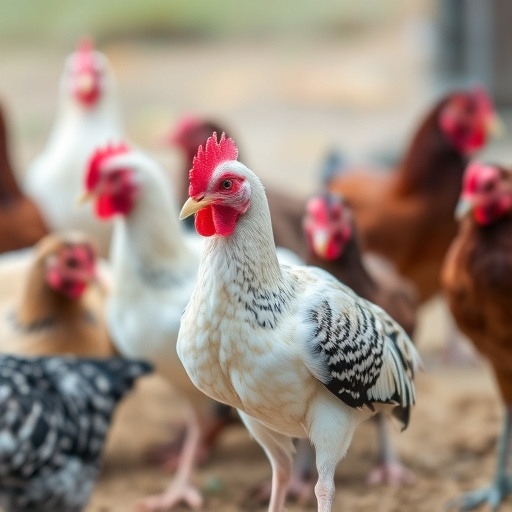In the ever-evolving realm of virology, understanding the transmission dynamics and stability of pathogens remains crucial for public health interventions. Among these pathogens, H5N1, a highly pathogenic avian influenza virus, has drawn considerable attention due to its pandemic potential and impact on both human and avian populations. The study by Dixit et al. (2025) explores an important aspect: the effectiveness of various transport media in preserving the viability of the H5N1 virus during transport and analysis, which could have significant implications for veterinary and public health practices.
When dealing with viral pathogens, maintaining their integrity during transport is foundational for accurate diagnosis and subsequent epidemiological assessments. One key finding from the study indicates that not all transport media are created equal. Certain media may enhance virus stability, while others may inadvertently reduce infectivity during transit. The implications of these findings are vast, as they could affect outbreaks management in avian populations and inform strategies for monitoring human infections linked to poultry.
The research specifically delineates the performance of several transport media, including phosphate-buffered saline (PBS), viral transport medium (VTM), and specialized influenza transport media. Each medium exhibited distinct characteristics in terms of how effectively they maintained the H5N1 virus’s infectivity over varying periods. For example, the VTM demonstrated a high suitability for preserving viral RNA, which is essential for diagnostic testing, while PBS showed promising results in sustaining the live virus during short-term transport.
Evaluating viral transport media involves rigorous testing and methodological excellence. The authors employed quantitative RT-PCR and virus isolation techniques to assess the viability and infectivity of the H5N1 virus in different media. These methodologies are not only significant in virology but also in clinical microbiology, where accurate detection and quantification of pathogens are critical for implementing effective control measures.
In the context of an outbreak, rapid and reliable diagnostic testing is critical. The findings of Dixit et al. emphasize that using the appropriate transport media can reduce the time taken to identify infected birds, thereby enabling swift interventions that can curtail the spread of H5N1. The relevance of this study extends beyond academic interest; it addresses the core challenges faced by veterinary professionals and public health officials during avian influenza outbreaks.
Moreover, the use of appropriate transport media has implications for the surveillance of zoonotic diseases, where avian influenza is a key player. By ensuring that samples remain viable during transport, veterinary services can better track the epidemiological patterns of H5N1, offering crucial intelligence that shapes response strategies for future outbreaks. This is particularly vital in regions where poultry farming is prevalent and where the risk of zoonotic transmission is heightened.
The authors also discuss the potential cost-effectiveness of using certain transport media over others. When resources are limited, as they often are in many veterinary settings, the choice of transport medium can have significant implications on operational efficiency and overall disease management strategies. Such insights are critical for policymakers who aim to allocate resources effectively during an outbreak.
Among the test media, the specialized influenza transport medium is noted for its ability to preserve the nucleic acid integrity over longer periods, which is a critical factor when samples must travel extended distances to reach diagnostic laboratories. This finding could significantly enhance efforts in remote areas where immediate access to medical facilities is not feasible, thus ensuring that surveillance efforts can continue unabated.
Furthermore, the quality of specimen collection, handling, and transport is paramount in diagnosing viral infections accurately. The study underscores that the international standards for viral diagnosis and containment should include recommendations for specific transport media based on empirical evidence. Such standardization not only facilitates better management of avian influenza but also improves global health security.
As the world continues to grapple with emerging infectious diseases, the relevance of studies like this one cannot be overstated. The implications of Dixit and colleagues’ findings resonate in a broader context; they highlight the intricate relationship between laboratory practices, infectious disease surveillance, and public health intervention strategies. A holistic approach to understanding these linkages will be essential in preparing for future pandemics, especially those of zoonotic origins.
In conclusion, the research conducted by Dixit et al. elucidates a critical facet of viral pathology and surveillance. By comparing various transport media for the H5N1 virus, the study represents a significant effort to bolster the preparedness and response capabilities of veterinary and public health entities in the face of potentially devastating outbreaks. The recommendations emerging from this work provide a framework for future research and practical applications in the ongoing struggle against avian influenza and similar viral threats.
Such investigations not only explore fundamental questions in virology but also reinforce the significance of evidence-based practices in health management. As veterinary and public health continue to converge, the findings underscore an urgent need for integrated approaches that ensure timely responses to infectious disease threats.
Subject of Research: Comparative evaluation of different transport media for H5N1 highly pathogenic avian influenza virus.
Article Title: Comparative evaluation of different transport media for H5N1 highly pathogenic avian influenza virus.
Article References: Dixit, B., Murugkar, H.V., Nagarajan, S. et al. Comparative evaluation of different transport media for H5N1 highly pathogenic avian influenza virus. Sci Rep 15, 39205 (2025). https://doi.org/10.1038/s41598-025-15987-6
Image Credits: AI Generated
DOI: https://doi.org/10.1038/s41598-025-15987-6
Keywords: H5N1, avian influenza, transport media, virus stability, public health, veterinary science, epidemiology, outbreak management.
Tags: diagnostic accuracy in virologyepidemiological assessments of H5N1H5N1 avian influenza virusimpact of transport media on virus viabilityinfluenza transport media comparisonmonitoring human infections from poultryoutbreak management strategiespublic health interventions for influenzatransport media for virusesveterinary practices for avian influenzaviral stability during transportvirology research implications





